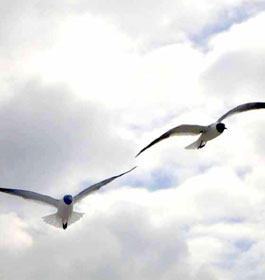


























|
|
Many people today are unaware of the natural and historical processes that have taken place in the formation of Georgia’s salt marshes.
 Equally not understood is the unique role the salt marshes play in maintaining the delicate balance of nature so vital along the coastal estuaryCreated as a result of melting
glaciers during the ice ages, the
origin of Georgia's marshlands can
be traced back to the Holocene
melting of the continental glaciers. Equally not understood is the unique role the salt marshes play in maintaining the delicate balance of nature so vital along the coastal estuaryCreated as a result of melting
glaciers during the ice ages, the
origin of Georgia's marshlands can
be traced back to the Holocene
melting of the continental glaciers.
One theory suggests that sediment, sand and soil brought down by the rivers, blown by the wind and washed ashore by the waves
gradually built up into ridges and dunes on the landward side of the shoreline. Water from the melting glaciers resulted in rising sea levels that flooded the coast and mainland, giving the ridges prominence as
barrier islands.
Ocean waters behind these islands formed lagoons, and later the marshlands. This process took place several times; thereby creating additional marshes between more barrier islands, and finally the salt marshes as we know them today.
The coastal marshlands were developed from lagoons that filled alterniflora, with sediments and deposits from rivers and streams flowing to the ocean. During this process Georgia’s coastal marshlands gradually began to assume their status as a vital part of one of the world's greatest
estuaries. |
|
|
Symbolic of the salt marshes is a tall cordlike grass call , which virtually covers the coastal marsh area. The environment in which the grass flourishes is neither all terrestrial nor all marine, but rather a combination of both actually prefers a fresh water environment. However, it is not often found there because of competition from other species.
 In
the zone where land meets a saltwater bay, very few plants can survive. However, is abundant in this area because of an evolved adaptation. While other plants die when
inundated by saltwater at high tide, cordgrass
has the ability to remove most of the salt from
the water it uses. This is accomplished by
keeping high concentrations of dissolved solids
in the root structure and extracting salt through
highly specialized salt glands on the leaves. In
the zone where land meets a saltwater bay, very few plants can survive. However, is abundant in this area because of an evolved adaptation. While other plants die when
inundated by saltwater at high tide, cordgrass
has the ability to remove most of the salt from
the water it uses. This is accomplished by
keeping high concentrations of dissolved solids
in the root structure and extracting salt through
highly specialized salt glands on the leaves.
These plants are hardy. They have extensive
underground structures, both leaves and stems.
The plant roots grow horizontally, giving rise to
new plants. This allows for fast colonization of
the salt marsh. And because the structure is
underground, the plant is protected from
hazards such as freezing or fire.
Some
scientists estimate that the below-ground Spartina alterniflora biomass of Spartina can be as much as 2 1/2 times that of the visible, above-ground parts. That's important, because these structures hold the marsh together and slow erosion. |
|
|
Productive almost beyond comprehension,
this salt marsh grass is responsible for the continuation and survival of the intricate balance of nature within the estuarine ecology. Producing nearly twenty tons to the acre, it is 4 times more productive than the most carefully cultivated corn.
Because Georgia has
approximately 1/3 of the remaining salt marsh on the East Coast, Georgia's salt marshes produce more food energy than any estuarine zone in any other eastern seaboard state.
 Truly the ocean tide is the lifeblood of the
marsh, bringing its subsidy with each coming and going. The incoming tide nourishes and feeds the grasses of the marsh. The out-going tide harvests its products and, through the tidal energy, breaks down the grasses and feeds the resources to the sea. Truly the ocean tide is the lifeblood of the
marsh, bringing its subsidy with each coming and going. The incoming tide nourishes and feeds the grasses of the marsh. The out-going tide harvests its products and, through the tidal energy, breaks down the grasses and feeds the resources to the sea.
Coastal tides average approximately 6 1/2 feet in the marshes but exceed 10 feet during high spring tides.
The grasses flourish in their habitat that is fed from the onrushing tides. As the grasses die and decompose, nutrient by-products are produced. Taken by the outgoing tides, these by-products feed an ever-growing number of organisms until all forms of marine life in the estuary have benefitted.
These minute decaying
particles feed small fish, plankton, oysters, shrimp, clams and crab. The marsh serves as a nursery ground for the growing juveniles of fish and shellfish, and these fish in turn support larger fish and so the cycle goes on and on.
In
addition, the stems and grass provide refuge for many adult animals in estuaries where salt and fresh water mix.
Salt marsh provides nutrients for other plants and animals. Smooth cordgrass winds up as floating plant particles. A
certain portion of the dead plant's pieces, or detritus, is consumed directly by herbivorous animals. |
 Smooth cordgrass and other plant material is an important food resource for many small estuarine animals. A big portion of this dead organic matter is carried to sea by tidal action. At sea, just as in the marsh, both physical and biological forces attack and break down the grass to its component nutrients. Smooth cordgrass and other plant material is an important food resource for many small estuarine animals. A big portion of this dead organic matter is carried to sea by tidal action. At sea, just as in the marsh, both physical and biological forces attack and break down the grass to its component nutrients.
Some of it is grazed upon directly by oceanic
herbivores, but most is attacked by decomposing bacteria and fungi. Nutrients released are then absorbed by microscopic plants called phytoplankton, which utilize them along with sunlight to produce their own organic matter. These, in turn, are fed upon by
larger zooplankton, which are microscopic but
larger than phytoplankton. Small fish feed on zooplankton.
The small
fish are fed upon by big fish. Any break in this food chain will affect all of the levels above it if something happens to remove production from the marsh. The marsh serves as a primary nursery ground for many economically important fish and shellfish. Were it not for the marsh, the juvenile populations of Spartina, our crabs, shrimp, and fish would be greatly reduced. |
 The commercial
catches offshore of many popular food fish show a direct relationship to the ratio of marsh versus open water inshore. In other words, in regions where the inshore areas contained numerous salt marshes, the offshore regions yielded more fish and other important food species. The commercial
catches offshore of many popular food fish show a direct relationship to the ratio of marsh versus open water inshore. In other words, in regions where the inshore areas contained numerous salt marshes, the offshore regions yielded more fish and other important food species.
Catches of many species of
shrimp are greatly increased by the amount of vegetated marsh directly inshore of the fishing area. Additionally, our salt marshes act as buffers against offshore storms. Without them, hurricanes, storm surges and northeasters on the Atlantic coast would cause much more damage and devastation.
The destructive fury of large stormspawned
waves and tides is greatly reduced by their passage across the marsh. The grass absorbs most of the energy, which lessens the damage that can be done.
Georgia's coastal marshlands encompass nearly 400,000 acres in a 4 to 6 mile band behind the barrier islands. Thriving in the waters of the estuaries, these marshes have been identified as one of the most extensive and productive marshland systems in the United States. |
| Contact and Address |
| Phone: (912) 264-7218 -Address: One Conservation Way, Brunswick Georgia 31520 - Glynn County - Directions I-95 S to Exit 29; Hwy 17 N to Conservation Way, on N end of Sidney Lanier Bridge. Park at GA Dept of Natural Resources (DNR). |
| Website Resources |
 Coastal Resources Division Coastal Resources Division |
|
|


Colonial Coast GA Travel Region Printable Map

Check These Out:
 Printable GA Earth Day Nature Trail Map Printable GA Earth Day Nature Trail Map
 Earth Day Trail Brochure Earth Day Trail Brochure
 GA Coast Salt Marshes GA Coast Salt Marshes
GA Coast & Islands Fun:
 Festivals & Events Festivals & Events
 Free Outdoor Activities Free Outdoor Activities
 Tourist Centers Tourist Centers
 Travel Region Info Travel Region Info
|










